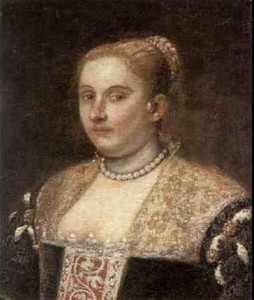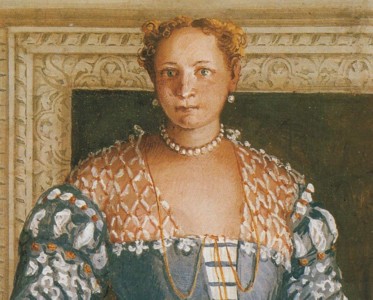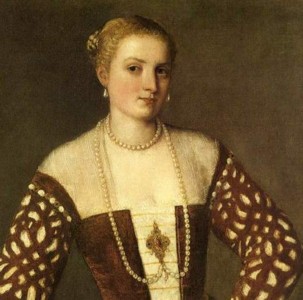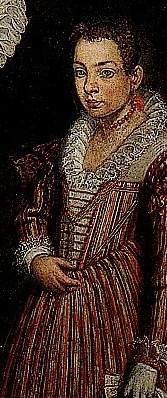 |
 |
| Portrait of a Woman 1545 - 50 Paris Bordone, [Balia dei Medici] Florence Uffizi Gallery | Ritratto Femminile (Violante)detail, Paris Bordon, , oil on canvas, 89,8 x 73,2 cm |
The Partlet
 |
 |
| Portrait of a Woman 1545 - 50 Paris Bordone, [Balia dei Medici] Florence Uffizi Gallery | Ritratto Femminile (Violante)detail, Paris Bordon, , oil on canvas, 89,8 x 73,2 cm |
The partlet is by no means essential for the completion of Venetian dress. There are many examples of Venetian dress being worn sans partlet. The partlet does however add a nice formality to the ensemble. There is nothing to indicate that it was worn by any class of woman, or only by married women as children also wear them.
Partletts can be divided into two categories, with a collar and without a collar. Technical I know. These can then be further categorised as structured and unstructured. The structured have shoulder seams and the unstructured appear to be a kin to a folded scarf pinned into place. These unstructured partletts would also appear to be the flimsy, I'm almost not wearing a partlet, sexy look.
 |

|
 |
| Portrait of a Girl (Lavinia) 1545 Titian Oil on canvas. Museo Nazionale di Capodimonte, Naples, Italy | Lavinia Tiziano possibly by Titiain | The Family Concert detail, Leandro del Ponte called Leandro Bassano, 1590 114 x 178 oil on canvas Uffizi |
 |
 |
 |
| The Marriage at Cana, detail of the bride 1571 Veronese Oil on canvas, 207 x 457 cm Gemäldegalerie, Dresden | Giustiniana Giustiniana and her nurse 1560-61 Veronese Fresco Detail Villa Barbaro Maser | Portrait of a Woman Detail 1560s Veronese oil on canvas 106 x 87 cm Douai, Musee de la Chartreuse |
Partletts would have been made of various fabrics and fibres; lace, organza, linen, silk and ribbon or cord. Embellished with embroidery, lace and beadwork, I’m not sure there is any such thing as ‘just’ a partlet in a Venetian wardrobe.
Partletts seemed to be stitched or pinned into the dress to help stop those very low shoulders falling right off. It’s the only way I could find to achieve the look without being disrobed.
 |
 |
 |
|
Veronese: Portrait of a Woman Herzog Anton Ulrich-Museum |
Veronese: Portrait of a Lady gia Parigi, collezione Lazzaroni |
Veronese: Portrait of a Girl aged 17 destined to become a Nun 1574 Louisville, J.B. Speed Art Museum |
 |

|
 |
| Girolamo Forni: Ritratto di gentildonne della famiglia Giusti del Giardino, detail, oil on canvas, 129 x 135 cm | Marietta Robusti, 1580 Self-Portrait | Madonna con Bambino, san Giovannino e donatori, 1530, oil on canvas, 101,8 x 135,6 cm |
Whilst it would appear
that a majority of partletts were worn entirely under the neckline of the dress,
there is some evidence that some were worn so that only the font and backs of
the partlet tucked into the gown while the shoulders are left to extend over the
shoulder straps of the dress. This
gives the illusion of a much wider neckline.
 Partletts
were not normally closed at the neck in Venetian dress, instead leaving the front open.
A small collar could be part of the partlet and a ruff, or standing ruff
might be added so that it did not extend the entire opening of the partlet.
Partletts
were not normally closed at the neck in Venetian dress, instead leaving the front open.
A small collar could be part of the partlet and a ruff, or standing ruff
might be added so that it did not extend the entire opening of the partlet.
Partletts
may have even bee worn in a kind of layer effect under outer garments such as
jerkins as seen in this detail form ‘Lady with a Squirrel’ by Francesco Montemezzano
housed at the Rijksmuseum Ansterdam.
No doubt it was worn for the aesthetics but I suspect for more practical
reasons also of keeping body oils from contacting the outer garment.
Washing a Partlet is easier that an entire garment.
There are many many more images displaying the wearing of partletts. What I have shown here is only the tip of the ice berg.
A Family receives an Abbess, Detached Fresco,
the Palazzo Regazzoni at Sacile near Pordenone
Francesco Montemezzano Gemaldegalerie Dreseen Detail
All intellectual content, composition, layout, designs and photographs, unless otherwise noted are copyright 2007 to Deborah Lane ©, or, copyright 2003 to Deborah Murray © also known as Mistress Oonagh O'Neill ©. All Original renaissance art works and artefacts are not copyright to Deborah Murray, and are shown for educational use only . If you see something you'd really like to use, please contact me!